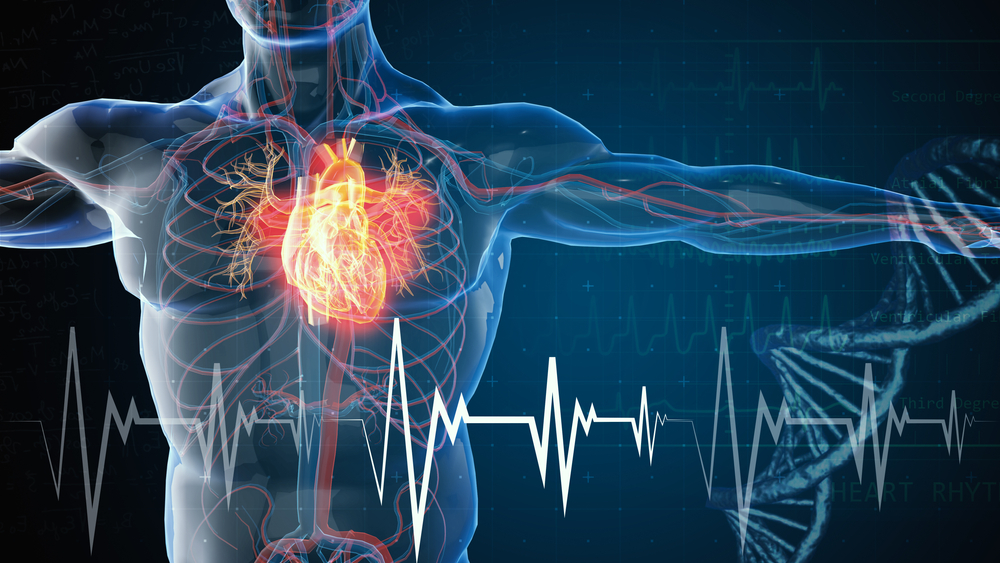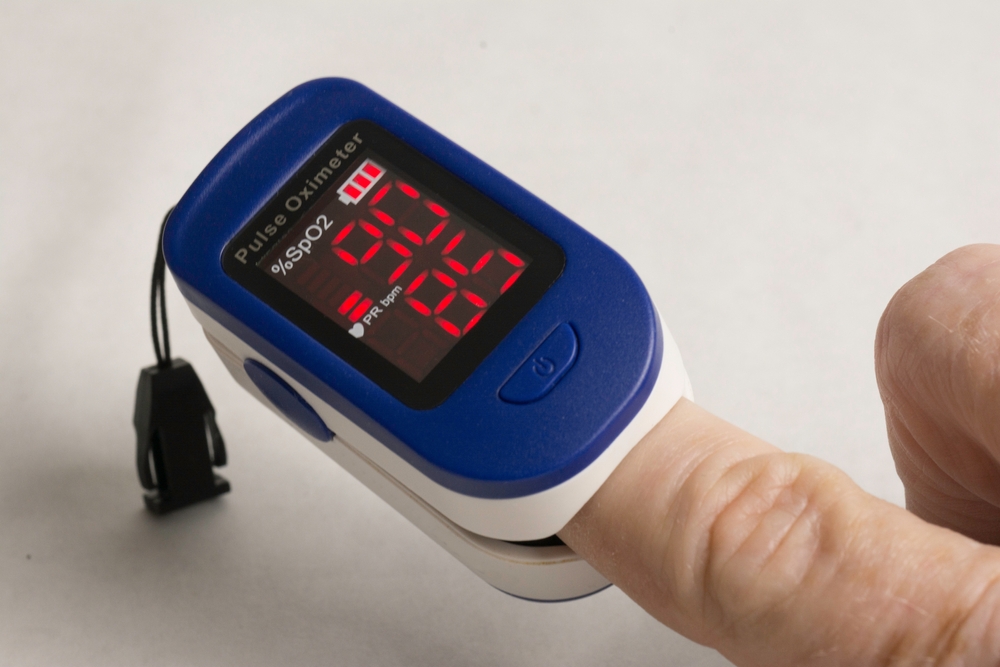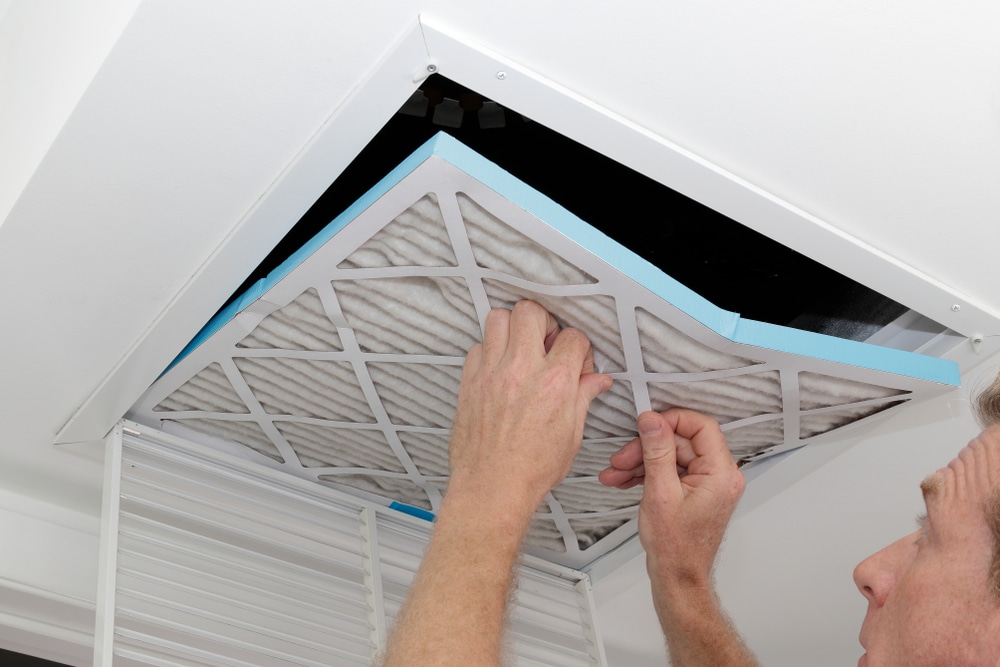Sleep apnea is a common sleep disorder that can have serious impacts on heart health. People with sleep apnea often snore loudly and experience interruptions in breathing during sleep, which can lead to low oxygen levels, elevated heart rate, and spikes in blood pressure.
These repeated disruptions to sleep can cause stress on the body, and over time, can increase the risk of developing cardiovascular disease.
Research has shown that sleep apnea can be a contributing factor to heart attack, stroke, and other heart-related health issues. It is important to recognize the potential risks of sleep apnea on heart health and take steps to manage the condition to prevent long-term complications.
In this blog post we will explain how sleep apnea affects your heart.

Sleep Apnea and Heart Disease
There is a strong link between sleep apnea and heart disease, and it is important to be aware of the potential risks to protect heart health.
Sleep apnea is a common sleep disorder that affects millions of people worldwide, and it is estimated that up to 70% of people with heart disease may also have sleep apnea.
Risk factors for heart disease, such as smoking, high blood pressure, and high cholesterol, can also increase the risk of developing sleep apnea.
During sleep apnea, the body responds with a stress response, which can lead to elevated heart rate, increased blood pressure, and changes in blood flow, putting added stress on the heart.
Over time, this added stress can cause damage to the heart muscle and lead to heart disease. The low oxygen levels that occur during sleep apnea can also cause damage to the heart and other vital organs.
The prevalence of sleep apnea and heart disease is significant, with up to 20% of adults estimated to have sleep apnea and over 80 million Americans having some form of cardiovascular disease.
Individuals with sleep apnea should take steps to manage the condition by making lifestyle changes, using medical devices, and working closely with healthcare providers to monitor heart health and manage sleep apnea effectively.
By taking these steps, individuals can reduce the impact of sleep apnea on their heart health and lower the risk of developing heart disease.
How Sleep Apnea Affects the Heart
Sleep apnea can have significant physiological effects on the heart, which can lead to the development of hypertension.
Hypertension, or high blood pressure, is a common health condition that affects millions of people worldwide and is a leading risk factor for heart disease.
When a person with sleep apnea experiences interruptions in breathing, the body responds with a stress response, which can cause a temporary elevation in blood pressure. This elevation in blood pressure can occur multiple times during the night, leading to chronic hypertension over time.
The low oxygen levels that occur during sleep apnea can also cause the blood vessels to constrict, which can further elevate blood pressure levels.
Additionally, the repeated disruptions to sleep can also lead to changes in hormone levels, including cortisol and aldosterone, which can contribute to the development of hypertension. Studies have shown that the relationship between sleep apnea and hypertension is bidirectional, meaning that individuals with hypertension are at a higher risk of developing sleep apnea, and vice versa.
In sleep apnea, there is a frequent activation of the sympathetic nervous system (SNS), which is responsible for the body’s “fight or flight” response. This activation can cause an increase in heart rate, hypertension, and other physiological changes that put added stress on the heart.
When the SNS is repeatedly activated during sleep due to the frequent interruptions in breathing, it can lead to chronic overstimulation of the heart and other organs, leading to cardiovascular damage and increased risk of heart disease.
The release of stress hormones, such as adrenaline and cortisol, can also cause inflammation and damage to the blood vessels, further increasing the risk of heart disease. Therefore, reducing the frequency and intensity of SNS activation through effective management of sleep apnea is essential to reduce the risk of heart disease and prevent further damage to the heart.
This highlights the importance of screening individuals with hypertension for sleep apnea and vice versa to ensure effective management of both conditions.
Effective management of sleep apnea can help reduce the risk of developing hypertension and other cardiovascular diseases, highlighting the importance of early diagnosis and intervention.
Elevated Heart Rate
Elevated heart rate is a common symptom of sleep apnea and can have significant impacts on heart health.
When a person with sleep apnea experiences interruptions in breathing during sleep, the body responds with a stress response, which can cause a temporary elevation in heart rate.
This elevation in heart rate can occur multiple times during the night, leading to chronic elevation over time. Elevated heart rate can put added stress on the heart, increasing the risk of developing heart disease. Studies have shown that there is a direct link between elevated heart rate and cardiovascular disease, with even slight elevations in heart rate associated with an increased risk of heart attack, stroke, and other cardiovascular events.
Additionally, elevated heart rate can also contribute to the development of hypertension, which can further increase the risk of developing heart disease. Effective management of sleep apnea, including the use of medical devices, lifestyle changes, and medications, can help reduce the risk of developing elevated heart rate and other cardiovascular diseases. It is important for individuals with sleep apnea to be aware of the potential risks of elevated heart rate and work closely with healthcare providers to manage the condition effectively to protect heart health.
Reduced SpO2
SpO2, or peripheral capillary oxygen saturation, is a measure of the amount of oxygen in the blood. Reduced SpO2 is a common symptom of sleep apnea and can have significant impacts on heart health.
When a person with sleep apnea experiences interruptions in breathing during sleep, the body is deprived of oxygen, leading to a reduction in SpO2. This reduction in SpO2 can put added stress on the heart and other vital organs, leading to the development of heart disease over time.
Low levels of oxygen in the blood can also cause the blood vessels to constrict, which can further decrease blood flow to the heart and other organs. This can lead to an increased risk of developing cardiovascular disease, including heart attack and stroke.
Studies have shown that the severity of sleep apnea is directly correlated with the degree of oxygen desaturation during sleep, highlighting the importance of effective management of sleep apnea to protect heart health.
Effective management of sleep apnea can help reduce the risk of developing reduced SpO2 and other cardiovascular diseases, highlighting the importance of early diagnosis and intervention.

Hypertension
Hypertension, or high blood pressure, is a serious medical condition that affects millions of people worldwide and is a leading risk factor for heart disease.
Hypertension is defined as a sustained elevation in blood pressure, with a reading of 130/80 mmHg or higher being considered high. There is a strong relationship between hypertension and sleep apnea, with studies showing that people with sleep apnea are at an increased risk of developing hypertension.
This increased risk is thought to be due to the intermittent hypoxia and repeated disruptions to sleep that occur with sleep apnea, which can lead to changes in the body’s stress response and hormones that regulate blood pressure. Additionally, the low oxygen levels that occur during sleep apnea can cause the blood vessels to constrict, further increasing blood pressure levels.
The prevalence of hypertension is significantly higher in people with sleep apnea than in the general population, with estimates suggesting that up to 50% of people with sleep apnea also have hypertension. Effective management of sleep apnea, including the use of medical devices, lifestyle changes, and medications, can help reduce the risk of developing hypertension and other cardiovascular diseases.
It is important for individuals with sleep apnea to be aware of the potential risks of hypertension and work to manage the condition effectively to protect heart health.
Risk of Cardiovascular Disease
People with sleep apnea are at an increased risk of developing cardiovascular disease, including heart attack, stroke, and other cardiovascular events. The repeated episodes of hypoxia, or low oxygen levels, that occur with sleep apnea can lead to damage to the walls of the blood vessels, increasing the risk of developing atherosclerosis, or the buildup of plaque in the arteries.
This buildup can cause the arteries to narrow, making it more difficult for blood to flow through and increasing the risk of heart attack and stroke. In addition, the repeated episodes of hypoxia can also cause changes in the body’s stress response and hormones that regulate blood pressure, increasing the risk of developing hypertension and other cardiovascular conditions.
Studies have shown that people with sleep apnea are at a significantly higher risk of developing cardiovascular disease than the general population, with some estimates suggesting that the risk may be as high as two to three times greater. Effective management of sleep apnea, including the use of medical devices, lifestyle changes, and medications, can help reduce the risk of developing cardiovascular disease and other complications.
Can Heart Damage from Sleep Apnea be Reversed?
The heart damage caused by sleep apnea can be reversed with the right treatment and management of the condition. When a person with obstructive sleep apnea experiences an interruption in air flow during sleep, the body responds with a spike in adrenaline and other stress hormones, leading to changes in blood flow, elevated heart rate, and increased blood pressure.
These factors can put added stress on the heart, leading to damage over time, which can result in heart disease, heart failure, and other cardiovascular conditions. However, with the right treatment and management, the damage to the heart caused by sleep apnea can be reversed, and the risk of heart disease can be reduced.
This may include making lifestyle changes such as losing weight, exercising regularly, quitting smoking, and avoiding alcohol and caffeine before bed. Additionally, medical devices such as continuous positive airway pressure (CPAP) machines or oral appliances may be used to keep the airway open during sleep, improving oxygen levels and reducing the risk of heart damage.
Metabolic Syndrome and Type 2 Diabetes
There is a growing body of evidence that suggests a strong connection between sleep apnea, metabolic syndrome, and type 2 diabetes.
Metabolic syndrome is a cluster of conditions, including high blood pressure, high blood sugar, excess body fat, and abnormal cholesterol levels, which increases the risk of heart disease, stroke, and other health problems. Sleep apnea has been shown to contribute to the development and worsening of metabolic syndrome by disrupting the body’s hormonal and metabolic systems.
Specifically, sleep apnea affects insulin production and regulation, which can lead to elevated blood sugar levels and eventually type 2 diabetes. Additionally, sleep apnea has been shown to increase inflammation in the body, which can contribute to the development of metabolic syndrome and its related conditions.
The relationship between sleep apnea, metabolic syndrome, and type 2 diabetes is complex, and it is not entirely clear which condition comes first. However, research suggests that treating sleep apnea may help to improve metabolic syndrome and reduce the risk of developing type 2 diabetes.
Types of Sleep Apnea
There are several different types of sleep apnea, each with varying impacts on heart health.
Obstructive sleep apnea (OSA) is the most common type and occurs when the muscles at the back of the throat fail to keep the airway open during sleep, leading to repeated episodes of apnea.
Central sleep apnea (CSA), on the other hand, is less common and occurs when the brain fails to send signals to the muscles that control breathing during sleep.
Complex sleep apnea syndrome (CSAS) is a combination of both obstructive and central sleep apnea.
While all types of sleep apnea can have an impact on heart health, OSA is most strongly associated with cardiovascular disease. OSA can cause a number of physiological changes in the body that increase the risk of developing heart disease, including changes in blood pressure, inflammation, and oxidative stress.
In addition, OSA can also lead to an increased risk of developing metabolic disorders, such as insulin resistance and type 2 diabetes, which can further increase the risk of developing cardiovascular disease.
While CSA and CSAS are less commonly associated with cardiovascular disease, they can still cause significant disruptions in sleep and lead to daytime fatigue and other symptoms that can negatively impact heart health.
Symptoms of Sleep Apnea
The most common symptoms of sleep apnea include loud snoring, pauses in breathing during sleep, gasping or choking during sleep, daytime fatigue, and difficulty concentrating or remembering.
While these symptoms can be disruptive to sleep and overall quality of life, they can also have a significant impact on heart health. The repeated episodes of apnea that occur with sleep apnea can cause a number of physiological changes in the body, including changes in blood pressure, heart rate, and oxygen levels, which can increase the risk of developing cardiovascular disease.
In addition, the disruption in sleep that is common with sleep apnea can cause changes in the body’s stress response and hormones that regulate blood pressure, further increasing the risk of developing hypertension and other cardiovascular conditions. Effective management of sleep apnea can help reduce the frequency and severity of symptoms, as well as the associated risk of developing cardiovascular disease.
Diagnosis of Sleep Apnea
The diagnostic process for sleep apnea typically involves a comprehensive evaluation of an individual’s symptoms, medical history, and physical examination, as well as a series of specialized tests to assess breathing and sleep patterns.
One of the most common tests used to diagnose sleep apnea is polysomnography, which involves monitoring a variety of physiological parameters during sleep, including brain waves, eye movements, muscle activity, heart rate, breathing, and oxygen levels. This test is typically performed overnight in a sleep laboratory and is considered the “gold standard” for diagnosing sleep apnea.
Another test that may be used to diagnose sleep apnea is a home sleep test, which involves the use of a portable monitoring device that records breathing and oxygen levels during sleep in the individual’s own home. This type of test may be recommended for individuals with suspected mild to moderate sleep apnea.
In addition to these tests, healthcare providers may also order imaging studies, such as a CT scan or MRI, to assess the structure of the airway and identify any potential obstructions.
Overall, the diagnostic process for sleep apnea is complex and requires the expertise of trained healthcare professionals to accurately identify and manage the condition. Individuals who experience symptoms of sleep apnea should speak with their healthcare provider to determine the most appropriate diagnostic testing and treatment options for their specific needs.
Treatment for Sleep Apnea
There are several different treatment options available for sleep apnea, ranging from lifestyle modifications to medical interventions.
One of the most effective treatments for obstructive sleep apnea is continuous positive airway pressure (CPAP) therapy, which involves wearing a mask over the nose or mouth during sleep that delivers a continuous flow of air to keep the airway open.
CPAP therapy is highly effective at reducing the frequency and severity of apnea episodes and improving overall sleep quality. However, it may not be well-tolerated by all individuals, and compliance with treatment can be challenging.
Other treatment options for obstructive sleep apnea include oral appliances, which help to reposition the tongue and jaw to keep the airway open, and surgical interventions, which may involve removing excess tissue in the throat or repositioning the jaw to improve airway function.
Lifestyle modifications, such as weight loss, smoking cessation, and avoiding alcohol and sedatives before bed, can also be effective in reducing symptoms of sleep apnea. While these treatment options can be effective at managing sleep apnea, there are limitations to each approach.
CPAP therapy can be cumbersome, claustrophobic and difficult to tolerate for some individuals, while surgical interventions
may not be appropriate for all individuals or may not be effective in all cases. Oral appliances can also be effective, but may not be as effective as CPAP therapy in reducing symptoms of obstructive sleep apnea.
Lifestyle modifications can be effective in managing symptoms, but may not be sufficient for all individuals with sleep apnea.
Ultimately, the most appropriate treatment approach will depend on an individual’s specific symptoms, medical history, and preferences. It is important for individuals with sleep apnea to work closely with their healthcare provider to determine the most appropriate treatment approach to manage their condition effectively and improve their overall health and well-being.
Sleep Apnea and Cardiovascular Disease: Role of Diabetes
The relationship between sleep apnea and cardiovascular disease is complex, and diabetes is a significant risk factor for both conditions. Research has shown that individuals with diabetes are at an increased risk for developing obstructive sleep apnea, and those with obstructive sleep apnea are at an increased risk for developing diabetes.
Both conditions share common risk factors, such as obesity and insulin resistance. Sleep apnea can exacerbate insulin resistance, leading to higher blood glucose levels, which can increase the risk of developing type 2 diabetes. In addition, the intermittent hypoxia that occurs during sleep apnea can cause oxidative stress and inflammation, leading to vascular damage and atherosclerosis, which can further increase the risk of cardiovascular disease in individuals with diabetes.
Conversely, individuals with diabetes are at a higher risk of developing cardiovascular disease, and sleep apnea can further increase this risk by contributing to hypertension and other cardiac risk factors. Treatment of both conditions is important for reducing the risk of cardiovascular disease, and lifestyle changes such as weight loss, regular exercise, and a healthy diet can be effective in managing both diabetes and sleep apnea.
Additionally, medical devices such as CPAP and oral appliances, as well as medications, can be used to manage obstructive sleep apnea and reduce the risk of cardiovascular disease in individuals with diabetes.
Sleep Apnea and Cardiovascular Disease: Role of Obesity
Obesity has been identified as a independent risk factor for both obstructive sleep apnea and cardiovascular disease. The link between obesity and obstructive sleep apnea is well-established, with excess weight leading to the narrowing of the upper airway, which increases the likelihood of airway collapse during sleep.
As a result, individuals with obesity are more likely to develop sleep apnea, which can then contribute to the development of cardiovascular disease. Obesity is also a risk factor for other cardiovascular disease risk factors, such as hypertension, insulin resistance, and dyslipidemia, which can increase the risk of heart attack and stroke.
Additionally, the adipose tissue in individuals with obesity produces inflammatory substances, such as cytokines, that can damage blood vessels and increase the risk of atherosclerosis, further contributing to the development of cardiovascular disease.
Addressing obesity through lifestyle changes such as healthy eating and regular exercise can not only improve sleep apnea symptoms but also reduce the risk of developing cardiovascular disease.

Lifestyle Changes
In addition to medical interventions, lifestyle changes can play an important role in reducing the impact of obstructive sleep apnea on heart health. One of the most important lifestyle changes individuals can make is to maintain a healthy weight, as excess body weight is a major risk factor for sleep apnea.
Studies have shown that weight loss can significantly improve symptoms of sleep apnea, and may even lead to a complete resolution of the condition in some cases. Regular exercise is also important for managing sleep apnea and improving heart health, as it can help to improve lung function and reduce the severity of apnea episodes.
Eating a healthy diet rich in whole grains, fruits, and vegetables, and low in processed foods and sugar, can also be beneficial for reducing symptoms of obstructive sleep apnea and improving overall heart health.
Avoiding alcohol and sedatives before bed can also be important for reducing the frequency and severity of obstructive sleep apnea episodes, as these substances can cause the muscles in the throat to relax and block the airway.
Making these lifestyle changes can be challenging, but they can have a significant impact on managing sleep apnea and reducing the risk of cardiovascular disease.
Medical Devices
There are several types of medical devices used to treat obstructive sleep apnea, including continuous positive airway pressure (CPAP) machines, bilevel positive airway pressure (BiPAP) machines, and oral appliances.
CPAP machines deliver a continuous stream of air pressure through a mask worn over the nose and/or mouth, which helps to keep the airway open and prevent apnea episodes. CPAP is known to be effective for mild, moderate and severe sleep apnea.
BiPAP machines work in a similar way, but deliver different pressures for inhaling and exhaling, which can be more comfortable for some individuals.
Oral appliances are custom-fitted devices worn in the mouth that help to reposition the jaw and tongue, keeping the airway open during sleep.
While any of these devices can be highly effective for treating obstructive sleep apnea and reducing the risk of heart disease, they must be used during sleep for the entire night to be effective.
Patients who discontinue care often report that any of these therapies can be uncomfortable and difficult to get used to. CPAP and BiLevel can be loud and the patient interface can be uncomfortable may cause pressure sources on the face, dryness or irritation of the nasal passages or mouth. These individuals may have difficulty adjusting to the use of a CPAP or BiPAP machine, and may require additional support and counseling to ensure adherence.
In some cases, surgery may also be an option for treating obstructive sleep apnea, particularly if it is caused by a physical obstruction in the airway, such as enlarged tonsils or a deviated septum. However, surgery is generally considered a last resort and is only recommended when other treatment options have been ineffective or cannot be tolerated.
Ultimately, the most appropriate medical device for treating obstructive sleep apnea will depend on the individual’s specific needs and preferences, and should be selected in consultation with a healthcare provider.
Continuous Positive Airway Pressure (CPAP)
CPAP therapy is the most common and effective treatment for obstructive sleep apnea. CPAP machines work by delivering a continuous flow of pressurized air through a mask worn over the nose and/or mouth during sleep. This pressurized air helps to keep the airway open, preventing episodes of apnea and hypopnea. The pressure setting on the machine is determined during a sleep study and is calibrated to the individual’s needs. The pressure may need to be adjusted periodically based on the individual’s response to therapy.
One of the major benefits of CPAP therapy is that it is highly effective in reducing the severity and frequency of apnea episodes and is indicted for mild moderate and severe sleep apnea. This, in turn, reduces the risk of cardiovascular disease and other health complications associated with obstructive sleep apnea. CPAP therapy has also been shown to improve daytime functioning, reduce fatigue, and improve overall quality of life for individuals with sleep apnea.
However, there are some limitations to CPAP therapy. One of the main challenges is that it can be difficult for some individuals to tolerate wearing the mask and keeping it in place during the night. Some individuals may experience skin irritation or dryness of the nasal passages or mouth as a result of the mask or the pressurized air. CPAP machines can also be noisy, which can be disruptive to sleep for some individuals.
Some individuals may experience difficulty adjusting to the pressure settings on the machine, and may require additional support and one on one counseling with a trained healthcare provider to ensure compliance.
In order to be effective the CPAP machine must be used consistently and correctly whenever the patient falls asleep, even during naps, as failure to do so can increase the risk of heart disease and sudden cardiac death.
Oral Appliances
Oral appliances, also known as mandibular advancement devices, are a treatment option for obstructive sleep apnea that work by positioning the lower jaw forward to help keep the airway open during sleep.
The devices are custom-made by a dentist or orthodontist to fit the individual’s mouth and teeth. Oral appliances are typically worn only during sleep and are designed to be comfortable and easy to use.
One of the main benefits of oral appliance therapy is that it is a non-invasive, non-surgical treatment option that is generally well-tolerated by individuals. Oral appliances are also highly effective in reducing the severity and frequency of apnea episodes, and can be a good alternative to CPAP therapy for individuals who have difficulty tolerating the mask and pressure of the machine or who suffer from milder forms of obstructive sleep apnea.
However, there are some limitations to oral appliance therapy. The effectiveness of the device may vary based on the severity of obstructive sleep apnea, and the individual’s unique anatomy. Additionally, oral appliances may not be appropriate for individuals with certain dental or jaw conditions like loose or missing teeth or TMJ disorders.
It is important for individuals to work closely with their dentist to ensure that the oral appliance is fitted correctly and titrated appropriately to optimize its effectiveness. Regular follow-up visits may be necessary to monitor the individual’s response to the therapy, and to continue to adjust the appliance as needed.
Overall, oral appliance therapy is a highly effective and well-tolerated treatment option for sleep apnea, with the potential to reduce the risk of cardiovascular disease and improve overall health and quality of life.
However, it is important for individuals to work closely with a trained dentist to ensure that the device is fitted and used correctly, and to address any concerns or difficulties they may have with the therapy. With proper support and monitoring, oral appliance therapy can be a highly effective treatment option for individuals with sleep apnea.
Surgery
Surgical options are available for the treatment of obstructive sleep apnea, although they are generally considered to be a last resort after non-surgical options have been tried and have not been effective. The most common surgical procedure for sleep apnea is uvulopalatopharyngoplasty (UPPP), which involves removing excess tissue from the back of the throat, including the uvula, tonsils, and part of the soft palate.
Other surgical options for obstructive sleep apnea include genioglossus advancement, in which the tongue is repositioned forward, and hyoid suspension, in which the hyoid bone in the neck is repositioned to help keep the airway open. Maxillomandibular advancement involves repositioning the upper and lower jaw to open the airway, while tracheostomy involves creating a hole in the neck to allow air to bypass the obstructed airway.
The benefits of surgical options for obstructive sleep apnea can include significant reductions in the severity and frequency of apnea episodes, as well as improvements in overall health and quality of life. However, there are also limitations and potential risks associated with surgical options.
Surgical procedures may be associated with discomfort, pain, and the need for a recovery period, as well as potential risks such as bleeding, infection, and complications related to anesthesia. Additionally, the effectiveness of surgical options may vary depending on the individual’s unique anatomy and the severity of obstructive sleep apnea.
In general, surgical options are considered to be a last resort for the treatment of sleep apnea, and are typically reserved for individuals who have not responded to non-surgical treatment options. It is important for individuals considering surgical options to work closely with their healthcare providers to understand the potential benefits and risks of each procedure, and to carefully weigh these factors in making a decision about treatment. Regular follow-up visits may be necessary to monitor the individual’s response to the surgery, and to address any issues or concerns that arise during the recovery process.
Medications
Medications can play a role in the treatment of obstructive sleep apnea and related conditions such as hypertension.
One medication option is the use of stimulants, such as modafinil, to help reduce daytime sleepiness in people with sleep apnea. In addition, medications used to treat hypertension, such as angiotensin-converting enzyme (ACE) inhibitors and beta-blockers, may also be effective in reducing the cardiovascular risk associated with sleep apnea.
However, medications also have limitations and potential side effects, such as the risk of developing a dependency on stimulants or experiencing adverse effects from hypertension medications. It is important to discuss medication options with a healthcare provider and weigh the potential benefits and risks before making a decision on the most appropriate treatment approach.
Monitoring Heart Health
Monitoring heart health is an important part of managing obstructive sleep apnea, as the condition can have a significant impact on the cardiovascular system.
One of the most important monitoring tools is regular blood pressure checks to monitor for hypertension, which is a common complication of sleep apnea.
People with sleep apnea should also undergo regular heart monitoring, which may include electrocardiograms (ECG or EKG) to evaluate the heart’s electrical activity, echocardiograms to assess the heart’s structure and function, and Holter monitoring to track heart activity over a longer period of time.
In addition, measuring oxygen saturation levels with a pulse oximeter during sleep can provide insight into the impact of obstructive sleep apnea on oxygen levels, which can be helpful in identifying potential cardiovascular complications.
It is important to work with a healthcare provider to determine the most appropriate monitoring approach based on individual health needs and history. Regular monitoring can help identify any potential cardiovascular complications early, allowing for timely intervention and management to reduce the risk of long-term damage.
Working with Your Healthcare Provider
When treating obstructive sleep apnea (OSA), there are several healthcare professionals involved in providing care to the patient.
The primary care provider or general practitioner (GP) is typically the first point of contact for patients experiencing sleep apnea symptoms. The GP may do initial screening with questionnaire like the ESS if required the GP will order refer the patient to a sleep specialist if necessary.
What is a sleep specialist?
A board-certified sleep specialist is a physician who has completed additional training in the diagnosis and treatment of sleep disorders, including sleep apnea. To become a board-certified sleep specialist, one must first complete a residency in a primary care field such as internal medicine, family medicine, or pediatrics, followed by a fellowship in sleep medicine.
During the fellowship, sleep specialists receive specialized training in the diagnosis and treatment of sleep disorders, including sleep apnea, as well as in the interpretation of sleep studies. They also learn how to use a variety of treatment modalities, including continuous positive airway pressure (CPAP), oral appliances, and surgery.
Once they have completed their training, sleep specialists work in a variety of settings, including sleep centers, hospitals, and clinics.
They are responsible for evaluating patients with sleep disorders, including sleep apnea, and developing treatment plans based on the individual’s apnea hypopnea index and respiratory disturbance index. Which involves ordering sleep studies, either in a sleep lab or a home sleep study, to diagnose sleep apnea, interpreting the results of the study, and recommending appropriate treatments.
What is a Sleep Lab?
A sleep lab, also known as a polysomnography (PSG) facility, is a medical center equipped with specialized equipment to evaluate sleep disturbances and diagnose sleep disorders, including sleep apnea.
A sleep lab typically has private bedrooms that are designed to be comfortable and resemble a typical bedroom. During a sleep study, the patient is connected to various sensors that measure different aspects of sleep, including brain activity, heart rate, breathing patterns, oxygen levels, and muscle movements. The polysomnographic (PSG) technologist monitors the patient throughout the night to ensure that the sensors are working correctly and to collect data on sleep patterns.
When arriving at a sleep lab, patients can expect to be shown to a private room where they will be given time to get ready for the study. The PSG technologist will then attach sensors to the patient’s head, face, chest, and legs. The sensors are painless and do not interfere with sleep. The PSG technologist will explain the process and answer any questions before the patient goes to bed.
What is a Home Sleep Study?
A home sleep study, on the other hand, is a simplified version of a sleep lab study that can be done in the patient’s home, which is typically a much easier place for falling asleep. The patient is given a small device to take home and wear during the night, which measures breathing patterns, oxygen levels, and other important factors.
A home sleep study is usually recommended for patients who have a high likelihood of having obstructive sleep apnea, but who do not have other significant medical conditions that would require additional monitoring.
While home sleep studies can be convenient, they may not provide as much information as a PSG done in a sleep lab. PSGs are considered the gold standard for diagnosing sleep disorders, and a sleep lab provides a controlled environment where the PSG technologist can monitor the patient’s sleep in real-time and make adjustments as needed. Additionally, home sleep studies may not be covered by insurance, whereas PSGs done in a sleep lab typically are.
What is an ear, nose, and throat (ENT) specialist?
An ear, nose, and throat (ENT) specialist, also known as an otolaryngologist, is a medical doctor who specializes in the diagnosis and treatment of disorders of the head and neck, including the ears, nose, throat, and related structures of the respiratory and upper digestive systems.
In the context of obstructive sleep apnea, ENT specialists can be involved in the evaluation and treatment of certain anatomical factors that contribute to obstructive sleep apnea, such as enlarged tonsils, adenoids, or a deviated septum.
They may also perform surgical procedures to remove or reduce these structures, as well as other types of surgeries that can help to open up the airway and improve breathing during sleep.
Common surgical procedures for obstructive sleep apnea include tonsillectomy, adenoidectomy, uvulopalatopharyngoplasty (UPPP), and maxillomandibular advancement (MMA).
How do Dentists treat Sleep Apnea?
Dentists can treat obstructive sleep apnea using oral appliances that are worn during sleep. These devices work by repositioning the jaw and tongue to keep the airway open and reduce the severity of apnea episodes. Oral appliances are typically custom-made for each patient and may take several visits to the dentist to get the right fit.
The dentist will take impressions of the patient’s teeth and create a model of the mouth to create the appliance. Once the appliance is made, the dentist will fit the patient with the device and make any necessary adjustments to ensure it is comfortable and effective.
Patients can expect to visit the dentist periodically to check the fit of the appliance and make any necessary adjustments. Oral appliances are often used as an alternative to continuous positive airway pressure (CPAP) therapy, which some patients find uncomfortable or difficult to use.
Overall, dentists play an important role in the management of obstructive sleep apnea, and patients can expect personalized care and ongoing support to ensure their oral appliance is working effectively.
What is a durable medical equipment (DME) provider?
A durable medical equipment (DME) provider is a healthcare professional or business that specializes in the sale and rental of medical equipment and supplies. When it comes to obstructive sleep apnea, DME providers play an important role in providing patients with the necessary equipment to manage their condition.
Specifically, DME providers can supply patients with various types of CPAP machines, masks, and accessories that are used to treat obstructive sleep apnea. Patients can expect their DME provider to work closely with their healthcare team to ensure that they are receiving the appropriate equipment and supplies that are tailored to their specific needs.
This may involve helping patients to initiate CPAP treatment, providing ongoing support and education related to the use and maintenance of the equipment, and troubleshooting any issues that may arise during treatment. In addition, DME providers may also work with insurance companies and other payers to help patients obtain coverage for their equipment and supplies.
Overall, patients can expect their DME provider to play a crucial role in the management of their obstructive sleep apnea by providing the necessary equipment and support needed to ensure successful treatment.
Conclusion
In summary, sleep apnea is a common sleep disorder that can have a significant impact on heart health. People with sleep apnea are at an increased risk of developing cardiovascular disease, including hypertension, heart attack, and stroke.
Elevated heart rate and reduced SpO2 are common physiological effects of sleep apnea that can have negative consequences for heart health. There are different types of sleep apnea, central sleep apnea, obstructive sleep apnea and complex sleep apnea syndrome, each can have a different impact on heart health.
While lifestyle changes like weight loss, exercise, and healthy eating can help manage sleep apnea, medical interventions like CPAP therapy, oral appliances, and surgery may also be necessary.
It is important to talk to your family doctor to determine the best treatment strategy, and to monitor heart health regularly.
As a call to action, readers are encouraged to take steps to manage their sleep apnea and protect their heart health by seeking treatment, making lifestyle changes, and working collaboratively with their healthcare provider to manage the condition.
References
American Heart Association. (2018). Sleep apnea and heart disease, stroke. https://www.heart.org/en/health-topics/sleep-apnea-and-heart-disease-stroke
Centers for Disease Control and Prevention. (2017). High Blood Pressure Fact Sheet. https://www.cdc.gov/dhdsp/data_statistics/fact_sheets/fs_bloodpressure.htm
Johns Hopkins Medicine. (n.d.). Sleep Apnea. https://www.hopkinsmedicine.org/health/conditions-and-diseases/sleep-apnea
National Heart, Lung, and Blood Institute. (2021). Sleep Apnea. https://www.nhlbi.nih.gov/health-topics/sleep-apnea
Mayo Clinic. (2021). Sleep apnea. https://www.mayoclinic.org/diseases-conditions/sleep-apnea/symptoms-causes/syc-20377631
American Sleep Apnea Association. (n.d.). Oral Appliance Therapy. https://www.sleepapnea.org/treat/sleep-apnea-treatment-options/oral-appliance/
American Sleep Apnea Association. (n.d.). Surgery for Sleep Apnea. https://www.sleepapnea.org/treat/sleep-apnea-treatment-options/surgery/
American Sleep Apnea Association. (n.d.). CPAP. https://www.sleepapnea.org/treat/sleep-apnea-treatment-options/cpap/
Mayo Clinic. (2021). Heart disease. https://www.mayoclinic.org/diseases-conditions/heart-disease/symptoms-causes/syc-20353118
National Heart, Lung, and Blood Institute. (2020). High Blood Pressure Medicines. https://www.nhlbi.nih.gov/health-topics/high-blood-pressure-medicines
American College of Cardiology. (2020). Monitoring Your Cardiovascular Health. https://www.cardiosmart.org/topics/monitoring-your-cardiovascular-health





